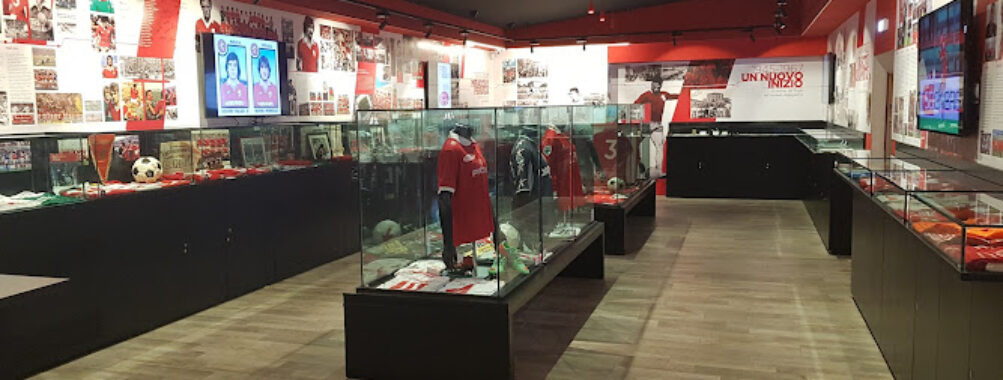
AC Perugia Calcio Museum
Table of Contents
Description
The AC Perugia Calcio Museum is one of those places that surprises you more than you’d expect. It’s not just a room full of jerseys and trophies; it’s a living memory of over a century of football passion in Umbria. Walking through the museum feels like stepping into a time capsule, where you can trace the club’s journey from its humble beginnings to its more recent battles on the pitch. The displays are thoughtfully arranged, and while some sections feel a bit modest, the overall effect is genuinely moving if you’re even remotely into football history.
What makes it special is the mix of professional curation and raw emotion. You’ll see vintage shirts that look like they’ve been through wars, photographs that capture both glory and heartbreak, and videos that bring the roar of the crowd back to life. It’s not a massive museum, but it doesn’t need to be. The intimacy of the space makes it easier to connect with the stories behind the objects. And honestly, even if you’re not a die-hard Perugia supporter, you’ll still walk away with a deeper appreciation for how much football means to this city.
There are a few spots where you can tell the exhibits could use a refresh, but that’s part of the charm. It doesn’t feel like a sterile, polished attraction—it feels authentic, built with love by people who care deeply about the club. Families often stop by, and kids seem to enjoy pointing out the old kits or watching the highlight reels. The museum is also accessible, with wheelchair-friendly entrances and restrooms, so it’s welcoming to all types of visitors.
Key Features
- Historic memorabilia including vintage jerseys, scarves, and trophies
- Video installations that replay iconic matches and unforgettable moments
- Four exhibition halls that guide you through different eras of the club’s history
- Wheelchair accessible facilities, including restrooms and parking
- Family-friendly environment, good for kids and school groups
- Free admission, making it an easy stop during a day in Perugia
- Rotating displays, so repeat visits can reveal new items
Best Time to Visit
If you want the museum to yourself, weekdays in the late morning are usually quieter. That’s when you can take your time with the displays without feeling rushed. On match days, the atmosphere is completely different—you’ll find fans buzzing with anticipation, and the museum takes on a celebratory vibe. Personally, I think visiting on a game day adds an extra layer of excitement, though it does get busier.
Spring and autumn are great seasons to plan a trip here, not only because the weather in Perugia is comfortable but also because the football calendar is in full swing. Summer can be hot and crowded, and winter has its charm too, especially if you like the idea of diving into football history before warming up with a hearty Umbrian meal nearby.
How to Get There
Reaching the museum is fairly straightforward once you’re in Perugia. If you’re staying in the city center, you can hop on local buses that head toward the stadium area—it’s a short ride and drops you close to the entrance. Taxis are also easy to arrange, and for those who prefer walking, it’s a manageable stroll from some neighborhoods, though the hills of Perugia can be a workout.
If you’re driving, there’s accessible parking available, which is a relief considering how tricky parking can be elsewhere in the city. For travelers arriving by train, the main station connects well with bus routes that get you near the museum in under 20 minutes. Honestly, the journey is part of the fun—you’ll pass through everyday Perugia life, seeing cafes, little shops, and locals going about their day.
Tips for Visiting
First tip: don’t rush. Even though the museum isn’t huge, give yourself at least an hour to wander. The details are what make it special—the stitching on an old jersey, the grainy footage of a legendary goal, the handwritten notes on a team sheet. If you breeze through, you’ll miss the little things that really bring the history to life.
Second, if you’re traveling with kids, prepare them with a bit of background about the club. Even a short story about Perugia’s underdog moments will make the visit more exciting for them. And for adults, it’s worth brushing up on some Italian football history before going; it gives context to what you’re seeing.
Third, bring a camera, but try not to spend the whole time behind it. I once caught myself snapping away at every display, only to realize later I hadn’t really looked at half of them. Take a few photos, sure, but let yourself soak in the atmosphere.
Lastly, if you can, pair your visit with a match. There’s nothing like seeing the passion of Perugia’s supporters in real life, then walking through the museum afterwards and realizing just how deep those emotions run. It’s the kind of experience that sticks with you long after you’ve left.
Location
Places to Stay Near AC Perugia Calcio Museum
Find and Book a Tour
Explore More Travel Guides
No reviews found! Be the first to review!